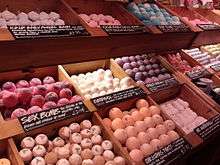Bath bomb

Bath bombs are hard-packed mixtures of dry ingredients which effervesce when wet. They are used to add essential oils, scent, bubbles or color to bathwater.
Composition
Bath bombs' primary ingredients are a weak acid and a bicarbonate base.[1] These are unreactive when dry, but react vigorously when dissolved in water to produce their characteristic fizzing over a period of several minutes. This is an acid-base reaction that involves conversion of citric acid and sodium bicarbonate to sodium citrate and carbon dioxide:
The other ingredients in bath bombs can vary considerably. However, most have scented ingredients as well as dye to impart a pleasant fragrance and color to bathwater. Lathering agents, such as sodium lauryl sulfate, are also often added to create bubble foams.
Production
Bath bombs are generally spherical but can be found in a variety of shapes, such as tablets or lumps. Shops offer a wide range of bombs, but they can also be made at home.
Potential health concerns
Although bath bombs are well tolerated by many people, some additives such as fragrances and dyes can cause irritation. Common skin irritants and allergens found in bath bombs include limonene, linalool and sodium lauryl sulfate.[2] The main ingredients - citric acid and sodium bicarbonate - are generally not considered as skin irritants when used in bath because of significant dilution in water.
References
- ↑ Buddies, Science. "Sudsy Science: Creating Homemade Bath Bombs". Scientific American. Retrieved 2016-12-25.
- ↑ Audrain, H.; Kenward, C.; Lovell, C. R.; Green, C.; Ormerod, A. D.; Sansom, J.; Chowdhury, M. M. U.; Cooper, S. M.; Johnston, G. A. (2014-08-01). "Allergy to oxidized limonene and linalool is frequent in the U.K". The British Journal of Dermatology. 171 (2): 292–297. doi:10.1111/bjd.13037. ISSN 1365-2133. PMID 24702129.
External links
